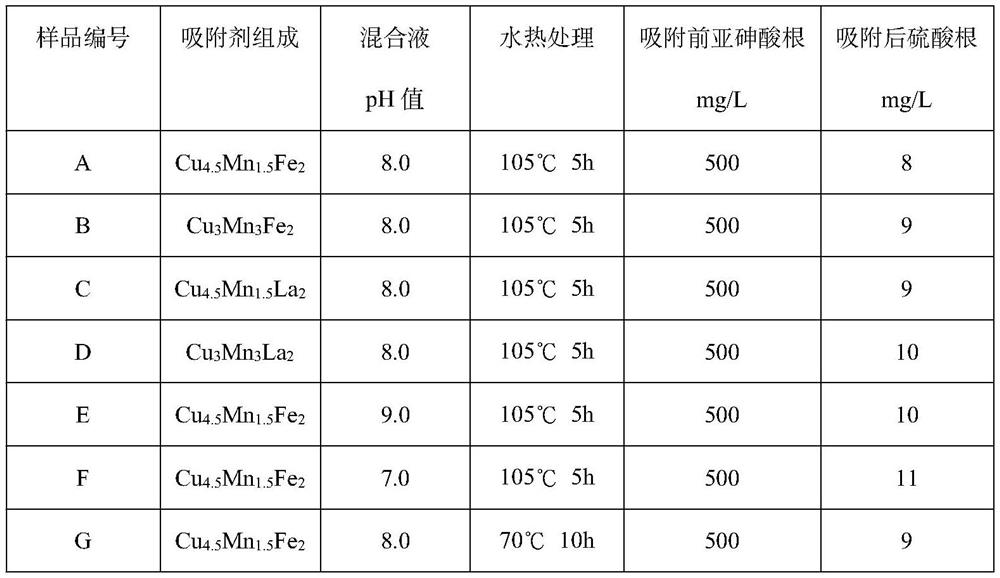Adsorbent for efficiently removing arsenite ion in water and preparation method thereof
A technology of arsenite and adsorbent, which is applied in chemical instruments and methods, adsorption water/sewage treatment, water pollutants, etc., can solve the problem of low removal efficiency of arsenite ions, and achieve fast adsorption speed and excellent adsorption Ability, high efficiency effect
- Summary
- Abstract
- Description
- Claims
- Application Information
AI Technical Summary
Problems solved by technology
Method used
Image
Examples
Embodiment 1
[0034] Dissolve copper nitrate, manganese nitrate and ferric nitrate in deionized water in a molar ratio of 4.5:1.5:2, stir at room temperature until clear, record as solution A; dissolve sodium hydroxide in deionized water, stir at room temperature until clear , denoted as solution B; quickly drop solution B into solution A, when the pH value of the solution stops at 8.0, continue stirring for 2 hours, pour the solution into the crystallization kettle, and perform hydrothermal treatment at 105 ℃ for 5 hours, filter, wash, and heat at 100 The adsorbent product A was obtained by drying at ℃ for 10 h.
[0035] 12g of adsorbent A was added to 1L aqueous solution containing 500mg of arsenite ions at 20°C, and the content of arsenite ions in the water was detected after stirring for 20min. The results are listed in Table 1.
Embodiment 2
[0037] Dissolve copper nitrate, manganese nitrate and ferric nitrate in deionized water in a molar ratio of 3:3:2, stir at room temperature until clear, and record as solution A; dissolve sodium hydroxide in deionized water, stir at room temperature until clear , denoted as solution B; quickly drop solution B into solution A, when the pH value of the solution stops at 8.0, continue stirring for 2 hours, pour the solution into the crystallization kettle, and perform hydrothermal treatment at 105 ℃ for 5 hours, filter, wash, and heat at 100 The adsorbent product B was obtained by drying at ℃ for 10 h.
[0038] 12g of adsorbent B was added to 1L aqueous solution containing 500mg of arsenite ion at 20°C, and the content of arsenite ion in the water was detected after stirring for 20min. The results are listed in Table 1.
Embodiment 3
[0040] Dissolve copper nitrate, manganese nitrate and lanthanum nitrate in deionized water in a molar ratio of 4.5:1.5:2, stir at room temperature until clear, and record as solution A; dissolve sodium hydroxide in deionized water, stir at room temperature until clear , denoted as solution B; quickly drop solution B into solution A, when the pH value of the solution stops at 8.0, continue stirring for 2 hours, pour the solution into the crystallization kettle, and perform hydrothermal treatment at 105 ℃ for 5 hours, filter, wash, and heat at 100 The adsorbent product C was obtained by drying at ℃ for 10 h.
[0041]12g of adsorbent C was added to 1L aqueous solution containing 500mg of arsenite ion at 20°C, and the content of arsenite ion in the water was detected after stirring for 20min. The results are listed in Table 1.
PUM
 Login to View More
Login to View More Abstract
Description
Claims
Application Information
 Login to View More
Login to View More - R&D Engineer
- R&D Manager
- IP Professional
- Industry Leading Data Capabilities
- Powerful AI technology
- Patent DNA Extraction
Browse by: Latest US Patents, China's latest patents, Technical Efficacy Thesaurus, Application Domain, Technology Topic, Popular Technical Reports.
© 2024 PatSnap. All rights reserved.Legal|Privacy policy|Modern Slavery Act Transparency Statement|Sitemap|About US| Contact US: help@patsnap.com










